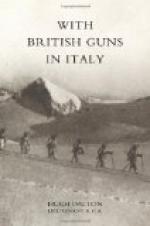My Battery was destined to remain here, with two short interludes, for seven months. It was in many ways a very interesting sector. The British held the line between the Italians on their left and the French on their right. To the right of the French were more Italians. The move had amusing features. One compared the demeanour of the lorry drivers of different nationalities. The scared faces of some of the British the first time they had to come up the hundred odd corkscrew turns on the mountain roads, taking sidelong glances at bird’s eye views of distant towns and rivers on the plain below, were rather comical. Even the self-consciously efficient and outwardly imperturbable French stuck like limpets to the centre of the road, and would not give an inch to Staff cars, hooting their guts out behind them. The Italian drivers, on the other hand, accustomed to the mountains, dashed round sharp corners at full speed, avoiding innumerable collisions by a fraction of an inch, terrifying and infuriating their more cautious Allies. But I only once saw a serious collision here in the course of many months.
The Asiago Plateau is some eight miles long from west to east, with an average breadth of two to three miles from north to south. On it lie a number of villages and small towns, of which the largest is Asiago itself, which lies at the eastern end of the Plateau and before the war had a population of about 8000. Asiago was the terminus of a light railway, running down the mountains to Schio. The chief occupation of the inhabitants of the Plateau had been wood-cutting and pasture. In Asiago were several sawmills and a military barracks. Army manoeuvres used often to take place in this area, which gave special opportunities for the combined practice of mountain fighting and operations on the flat. It was moreover within seven miles of the old Austrian frontier. Asiago was hardly known before the war to foreign tourists, but many Italians used to visit it, especially for winter sports.
Across the Plateau from north to south ran the Val d’Assa, which near the southern edge, having become only a narrow gulley, turned away westwards, the Assa stream flowing finally into the river Astico. The Ghelpac stream, which flowed through the town of Asiago, joined the Assa at its western turn. Apart from these two streams the Plateau was not well watered. In summer, when the snows had melted, water was even scarcer on the surrounding mountains. All our drinking water had to be pumped up through pipes from the plain.
The Plateau was bounded at its eastern end by Monte Sisemol, which stands at the head of the Val Frenzela, which, in turn, runs eastward into the Val Brenta near the little town of Valstagna. Sisemol was of no great height and was not precipitous. It had a rounded brown top, when the snow uncovered it. But it was a maze of wire and trenches, and a very strong point militarily. There had been very bitter fighting for its possession last November and it had remained in Austrian hands.




